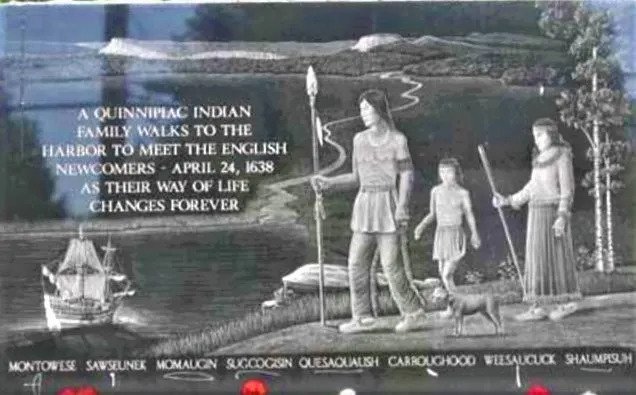Remembering our “First People”
Can we, today, even imagine the life of a Quinnipiac man, woman, or child? Is it possible to put oneself in the “shoes” of any individual who lived in a time so different from ours? Can we imagine a way of life that was so inextricably entwined with a “place” now that the “place” has changed so profoundly?
Archaeology has established that Native Americans inhabited Connecticut, specifically the area that became greater New Haven for more than 10,000 years.[1] Their numbers were substantial before traders brought diseases like smallpox and influenza against which native inhabitants had no resistance. Interaction with neighboring warlike tribes further depleted the population. By the time English colonizers arrived, the Eastern Woodland people, a grouping that included the Quinnipiac, are estimated to have lost 80% of their population.[2]
Prior to contact, the indigenous people lived dependent on the land and their own ingenuity. They incorporated every usable aspect of their dwelling place into their lifestyle – food and the means to procure and preserve it; shelter and protection; clothing and material culture; medicines; resources to address their community and spiritual needs. Sustainability and reciprocity were key concepts that governed indigenous life. Each “gift of nature” was honored with some small offering to acknowledge the bounty of the Creator in providing the resource. There was as little waste as possible. It was important to take only “enough” and that “enough” be left for “next time.” [3] The bounty of the land and the needs of the people were in a balance provided by the Creator, to take more than one needed, to waste, or to not be properly grateful were serious offenses. The land, the place inhabited by the Quinnipiac and other indigenous groups, was sacred to them.
Today, in the greater New Haven area, local residents and visitors alike are aware of the Quinnipiac name. As they drive down Quinnipiac Avenue, explore the Quinnipiac River, hike the Quinnipiac Trail, notice the names of commercial or professional concerns, or perhaps visit Quinnipiac University, it is impossible to remain unaware that the word “Quinnipiac” has a local significance. That an indigenous people known as the Quinnipiac were the earlier inhabitants of the area is generally acknowledged, but often little about the people themselves is known besides projectile points, in common parlance “arrowheads,” and possibly the agricultural “sisterhood” of corn, beans, and squash, The Three Sisters.
Additionally, it is often imagined that Native American groups who are not federally or locally (CT) recognized and/or who no longer have an identifiable local presence are “gone.” The popular belief is that the Quinnipiac, who seasonally ranged from summer camps along the shores of Long Island Sound into the interior for winter shelter, are extinct. This is a misconception. Cultural conflict, combined with a diminished population ultimately forced the departure of the remaining Quinnipiac from the area colonized by the English. They joined and were absorbed by neighboring tribes and “lost” their original identity. [4] This,
however, does NOT mean that they have “disappeared.” They did become, however, widely dispersed and often chose anonymity to avoid discrimination.
Archaeology, ethnology, anthropology, ecological history, and even some contemporary (17th and 18th century) travel journals offer us glimpses into their past, but we can never
truly know the landscapes in the same way that the Quinnipiac may have. Unless we are finely attuned, we can only acknowledge and respect that for indigenous people, “The Land is the Culture.” [5] As such, we honor and pay tribute to the those who were here first by respecting the land and engage as much as we can in the philosophy of reciprocity that influenced their every action.
[1] Lucianne Lavin, Connecticut’s Indigenous Peoples: What Archaeology, History, and Oral Traditions Teach Us About Their Communities and Cultures, (New Haven: Yale University Press, 2013), xii.
[2] William S. Simmons, Spirit of the New England Tribes: Indian History and Folklore, 1620-1984 (Hanover, NH: University Press of New England, 1986), 11-12.
[3] Laurie Weinstein, Enduring Traditions: The Native Peoples of New England (Westport, CT: Bergin and Garvey, 1994, xv; Kathleen J. Bragdon, Native People of New England: 1500-1650 (University of Oklahoma, 1996), 131.
[4] John Menta acknowledges that some individuals or small family groups may well have quietly remained in the area “blending” into other communities not broadcasting their heritage for fear of discrimination: John Menta, The Quinnipiac: Cultural Conflict in Southern New England (New Haven: Yale Peabody Museum, 2010), 207.
[5] “…how Native Americans feel about land from a leader of the Golden Hill Paugussetts, the tribe whose homelands were adjacent to Quinnipiac on the west (and with whom they were allied by marriage). Aurelius Piper (Chief Big Eagle), deceased chief of the Paugussett for many years, once observed that ‘The Land is the Culture’”. Lucianne Lavin, email, 2019.
This article was written by Julie Hulten and appeared in a previous issue of Giant News.
Photo credit: Julie Hulten. Monument to the Quinnipiac is located on Townsend Avenue in Fort Wooster Park.

